[youtube_view_count id=”5mIb8p3mYlQ”] views
Allen:
TB 118 safe electrical isolation of gas appliances. ACS GAS TRAINING. We’ve got Andrew from Socket and See and Andrew’s going to go over the new technical bulletin, TB 118 and he’s going to go over, he’s going to show us how to do safe isolation checks. Also, now with the new SES, this is going to be included in the SES as well. We do need to know how to work safely on boilers. I’ll pass you over to Andrew now.
Andrew:
I’ve done the safe-to-touch test. I know that I can touch the boiler. Next is the essential electrical checks and I need to access the boiler terminals for this. I’ve removed the two retaining screws from the front of the boiler. Just pop that off. I have switched the boiler off while I access these terminals. I’ll just drop the front, remove the two red retaining screws on this insulating panel, retain them for reassembly of the boiler, then lift this and we’ve got access to the terminals.
To do the essential electrical checks, I’m going to be using the Socket and See DLM Pro. I can use the magnetic strap to hold it in place on the boiler. I’ll then connect the earth, ensuring a nice clean connection. That’s very important for the testing. I’ll then connect the neutral and the live. And then I’ll switch the DLM Pro to the socket position before re-energising the boiler. That gives me my polarity checks and my incoming voltage checks. If any of those aren’t right, the DLM Pro won’t allow an earth loop impedance test, then simply switch to the loop position. It does a no-trip loop test. It shouldn’t trip the RCD and a healthy installation. Gives me an earth loop impedance reading right back from the transformer to the chassis of the boiler of 0.3 Ms and that’s a good indication on the metre. Then disconnection, remove the live, remove the neutral, remove the air and that’s the essential electrical checks completed on the boiler.
Now I’ve done the essential electrical checks. I’m going to safely isolate the boiler so I can do the servicing on it while it’s dead. I’ve removed the fuse from the fuse spur. I’m going to keep that safe and retain that myself. There are multiple locking off devices that can be used on fuse spurs or plug chops, for instance, the Socket and See log 10. Because I’m totally in control of the boiler, I won’t be fitting that. Maybe if it was going to the van to get some tools then I would fit that device. Now I’ve removed the fuse. I can assume that it’s safely isolated but I want to prove that it’s safely isolated. To prove safe isolation, I’m going to be using the Socket and See SP400 proving unit and the Socket and See VIP150 two-pole tester. The first thing we must do is use the SP400 to prove that the two-pole tester works correctly. Once I’ve proved that throughout the entire range, I can do the checks on the boiler terminals.
I’ll be checking from earth to live connecting to the earth first, from neutral to live, connecting to the neutral first and finally from earth to neutral. And we mustn’t have any have indications during any of these checks. Again, we can assume that the boiler is safely isolated, but we’ve got to prove operation of the VIP150 again. Yeah, I’ve proved that operates throughout its entire range. We’re save to continue with our power-off checks.
Run through the entire TB118 process now, and you’ve seen how easy it is to comply as long as you’ve got the right information and the right test equipment. We now are going to take a closer look at the equipment that we use to carry out the process, starting with the Socket and See VVD Pro. It’s a non-contact voltage detector that operates from 50 to a thousand volts. And it’s ideal for carrying out checks on extraneous metalwork, such as boiler chassis, radiators, pipes, and taps, just to see if there’s any voltage present. If it doesn’t give an indication, you know it’s then safe to touch. It clearly indicates a voltage presence by the LED in the tip glowing red and the main tester of the body vibrating.
When we carried out our essential electrical tests, we use the Socket and See DLM Pro. This test has been specifically designed for the gas engineer. It’s a combined socket tester, earth loop impedance tester and multimeter. The socket and loop test have got blue indications. And that indicates that they used with the blue terminals on the top of the unit. The multimeter have yellow selections on the rotary dial. And that indicates that it’s used with these two yellow terminals. As well as giving a numerical value, the loop impedance range gives a good check or fail indication, obviously good in the case that everything’s fine, and then a check indication is anywhere between 1.8 and 93 ohms. This is where a gas engineer will need to interpret the earth arrangement of the property. If there’s a check indication, you’d start to think, “Is a TT earthing arrangement being used?” And you’d have to look for things like an earth rod coming down from the metre point or perhaps overhead lines supply in the property, which are obvious indications of a TT earthing arrangement.
The multimeter side, we’ve kept it nice and simple. You’ve got your AC volts, your DC volts, in continuity for doing your resistance checks and then an auto-north feature, which takes into account the resistance of the test leads, so you’ve got extra accuracy there. It doesn’t matter what you select on your multimeter, if ever there’s a voltage present, it’s fully protected, and it’ll give you a good, clear indication that there’s a voltage there. It comes with a magnetic fob, so you can attach it to the boiler chassis. And then it comes with compliant test leads, so all of the metal on the clips is insulated, so you’re not going to hurt yourself. And the exposed tips on the prods are all compliant. The cables and hardware are all silicon and there are also wear-indicating, so if you see any white coming through on the black, you know, it’s time to wear, to replace the cables.
The last part of the technical bulletin 118 process we looked at was the safe isolation process. For this, we use the Socket and See SP400 proving unit. It’s a true AC output proving unit from 50 to 690 volts, runs off six AA batteries, and it can be used for proving our non-contact voltage indicators and two pole testers. Of course, it’s best practise whenever using the voltage indicator to prove it before and after use. Can be used while it’s still in the case. Simply put the tester in the terminals and check its indication throughout its entire range. The VIP150 two-pole tester does exactly what it says on the tape. No selections to make, no leads to change, it’s all one fixed unit, no batteries required, and it’s purely a safe isolation piece of equipment. So obviously we do all the checks and check that there’s no indication given.
We now are going to look at all the testers in the Sockets and See range that will help gas engineers to comply with technical bulletin 118. Now we’re going to be looking at the Socket and See PDL 234. This is our entry level earth loop impedance tester to do the essential electrical checks as part of your technical bulletin 118 procedure. We look in the case, we’ve got the tester itself and then a 13- amp test lead for checking [inaudible 00:10:09], but it also comes with your flying test leads for checking at boiler terminals. For this demonstration, I’m just going to plug straight into the 13-amp socket.
As soon as we power the unit on, it does our socket test and tells us what voltage we have at present at the socket. Then simply press the loop test. It’ll perform a no-trip loop [inaudible 00:10:39] test, and then give us a go/no-go indication. In this case, we’re at less than one ohm, the earth loop impedance, and we’re happy that it’s a good result. It also has a polarity test path. So simply hold your thumb over that and if everything’s okay with the metre supplies terminals into the installation we’ll get three greens indicated, and it’s as simple as that.
Thanks very much for taking the time to watch the video on Socket and See and technical bulletin 118. If you’ve got any questions, please comment in the box below. For more information on the product range, you can see everything at www.socketandsee.co.uk.
Allen:
Thank you very much for that, Andrew. If you’ve got any questions, please ask them in the comments below. And if you’d like any more videos like this or anything more in-depth to do with what you need to do with TB 118 then again, please put some comments below and we’ll try and cover them as well, if possible. Thank you for watching.
[youtube_view_count id=”5mIb8p3mYlQ”]







